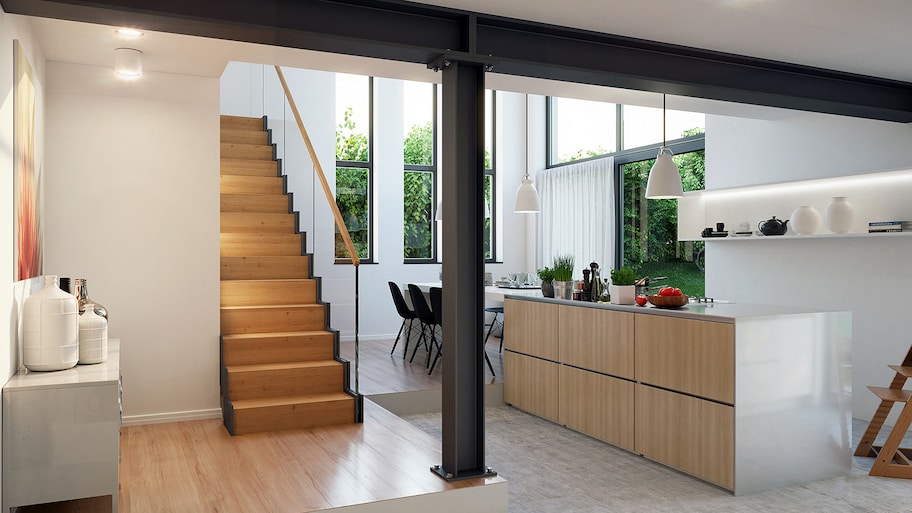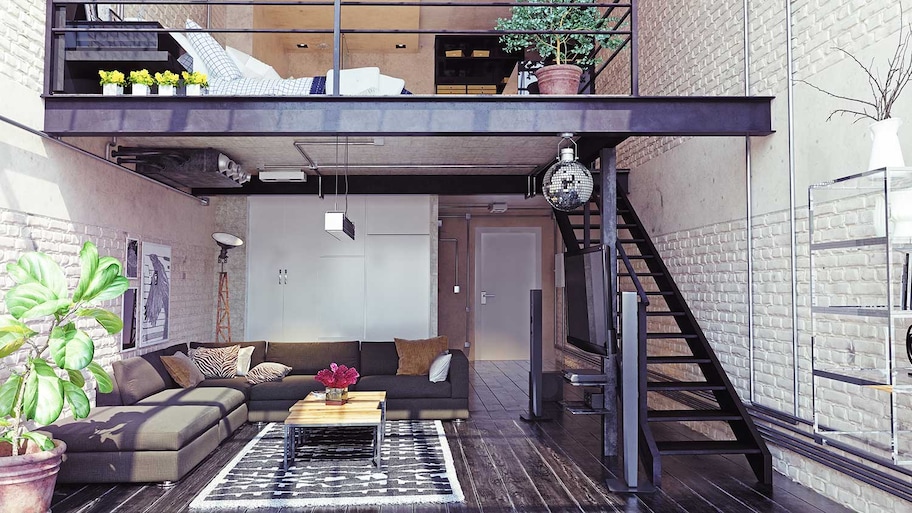How Much Does Beam Installation Cost? [2024 Data]
Normal range: $1,263 - $5,268
Beam installation costs an average of $3,250, and most projects total between $1,263 and $5,268, depending on the type of beam, the size, and more.


Beam installation costs average around $3,250, depending on whether you’re installing one in new construction or retrofitting one in your existing home. Prices can range from $225 up to $10,300, so understanding how to budget for beam installation is crucial before getting started with your renovation project.
In this guide, we’ll explain how to calculate beam installation costs so that you won’t be surprised when you start getting estimates from local contractors.
- Average
- $3,250
- Low end
- $225
- high end
- $10,300
Beam Installation Cost Factors
There are many factors to consider to get an accurate cost for beam installation, from the type of beam you need to the size and labor costs.
Type of Beam
There are a few kinds of beams that are common in residential construction that vary mostly based on the load they need to support. The type of beam you need will play a major role in the material costs and the labor costs required to install them in place.
For example, a decorative beam doesn’t need structural integrity, and since it’s for aesthetic purposes only, it won’t need installation behind walls, above or below ceilings, or beneath floors. On the other hand, a steel I-beam will support heavy loads and demand integration into your existing structure, so material and labor costs will be much higher.
The table below includes average prices for the different types of beams you might need in your home. Keep in mind that you can’t always choose the beam that your professional installs, as a structural engineer will often need to pick a material that will maintain the integrity of your structure.
| Type of Beam | Cost Range |
|---|---|
| Decorative | $875–$6,800 |
| Glulam | $1,200–$8,250 |
| LVL beam | $600–$3,300 |
| Steel I-beam | $1,200–$5,500 |
| Support | $1,500–$25,000 |
| Timber | $1,000–$8,250 |
Size
The size of the beam you need will also play a significant role in the cost, as you’ll pay per linear foot for materials in most cases, and labor charges will climb as the beam gets longer. For example, replacing the main support beam in your home costs more than most other beams due to the higher material and labor costs.
On average, you can expect to pay between $10 and $15 per linear foot, but your price will depend on the type of beam, which affects the material, delivery, and labor costs for installation.
The table below includes some prices on a per-linear-foot basis for the different types of beams you might need. These include materials and labor.
| Type of Beam | Cost Per Lin. Ft. |
|---|---|
| Decorative | $4–$24 |
| Glulam | $6–$30 |
| LVL beam | $3–$12 |
| Steel I-beam | $6–$20 |
| Support | $7–$90 |
| Timber | $5–$30 |
Delivery
Most beams in residential construction are significantly longer than standard lumber, often spanning 18 to 24 feet and, in the case of some steel I-beams that create open floor plans, up to around 100 feet. As such, you’ll need a specialized delivery service to get them to your property.
In most cases, your engineer or contractor will include the delivery fees in the material costs, but you should always double-check to be sure. If they aren’t included, you can expect to pay between $100 and $500.
Permits
Unless you’re installing a purely decorative beam, your renovations will alter the structural components of your house, which means you’ll need building permits. Permits can cost anywhere from $75 up to $400 or so to replace a beam, depending on your location, and most municipalities will require that you hire a structural engineer to pull the permits for you.
Taking Down Old Beam
A big portion of the labor that goes into installing a new beam is accessing and removing the old one. Your contractor will bake this cost into the total labor price because you normally wouldn’t have a beam installed without removing the existing one. The longer the beam you’re replacing, the more prep work your contractor will need to do, and the higher your labor costs will be. Longer beams will also drive up the cost of hauling away and dumping the old material.
Labor
Labor makes up the largest portion of your beam installation costs, accounting for around 80% of the total. Labor charges will often include the following:
Accessing the existing beam, which includes removing drywall, flooring, and other building materials.
Installing temporary supports for the home, like house jacks, to keep it standing while the beam is out.
Removing the old beam and hauling it away.
Maneuvering the beam into place, which can be extremely involved for longer beams that aren’t a part of new construction.
Refinishing your home to bring it back to its original condition.
As you might imagine, the location of the new beam in your home can play a big role in the labor costs. Replacing a support beam in a basement can cost as much as $25,000, while replacing a beam in an attic or easily accessible living area will top out around $5,268.
Ongoing Beam Installation Costs

Most of the time, the beams in your home won’t require any ongoing maintenance or repairs unless your home suffers structural damage. If you do have severe damage, you’ll often find that structural engineers recommend a full replacement rather than a repair.
The only ongoing costs you’re likely to run into would be wood support beams in a crawl space with a pier and beam foundation or a basement. In some cases, you’ll need to have a professional shim these to maintain level support for your home. Shimming support beams costs between $1,000 and $5,000, with an average of about $3,000. This work will be on an as-needed basis.
DIY vs. Hiring a Pro to Install a Beam
The beams in your home contribute to its structural integrity, so installing or replacing them is not a job suited for DIYers. In fact, most municipalities require that you have a licensed and certified structural engineer handle the beam design and oversee—if not participate in—the installation.
Working with the beams themselves is also extremely labor-intensive and dangerous, and it often demands specialized heavy equipment. “Because of their size and weight, steel beams are not only unwieldy, they can be quite dangerous,” says Bob Tschudi, Angi Expert Review Board member and general contractor in Raleigh, NC. “We clear the site to only essential workers from the time the beam is hoisted from the delivery truck until it is safely secured.”
If you still want to get your hands dirty with some DIY work, you can tackle the smaller portions of the job, like reinstalling and finishing drywall after the installation and fixing flooring, trim, and other finishings that the installation process disturbed.
Cost of Common Beam Installation Add-Ons
Installing or replacing beams in your home is a big job on its own, but you might want to consider the following add-on projects to make your renovation more complete.
Removing load-bearing walls: One popular reason to upgrade to something like a steel I-beam is to open up the floor plan, which involves removing load-bearing walls. You can expect to pay between $4,000 and $10,000 to tear down a load-bearing wall under your new beam.
Installing a new ceiling: Beams over living areas will require refinishing of the drywall on the ceiling. You’ll pay an average of $1,200 for this service if you have a professional tackle it for you.
Rewiring electrical wires: Depending on where your beam is located, you might need to pay to rewire light fixtures in your ceiling. Expect to pay between $6 and $10 per square foot.
Relocating HVAC system: If your new beam runs through an area where your HVAC ducts travel or underneath where your air handler sits, you’ll have to pay between $5 and $25 per linear foot for the ductwork or between $800 and $1,100 to relocate the air handler.
Rerouting gas lines: Rerouting gas lines that your new beam interferes with will cost between $120 and $1,400, depending on how far your plumber needs to move the lines and how easy it is to access them.
Layout design: You can pay between $300 and $6,000 for an interior designer to design a layout for your new space. This might be helpful if your beams are intended to open up your living area and replace load-bearing walls.
How to Save Money on Beam Installation and Replacement Costs
Installing and replacing beams can cost as much as {{nationalMaxCost}}, making it a relatively expensive project. However, there are some ways to save money in the process.
Choose a more affordable beam material. In cases where you have a choice of beam material, choose one that’s less expensive on a per-linear foot basis. For example, an LVL beam will cost less than a standard timber beam, and both are more affordable than a glulam beam. Speak with a local structural engineer to see what the most affordable beam suitable for your project is before choosing.
Maintain vertical supports under the beams. If you’re looking to remove load-bearing walls to open up your living space, you could save money by leaving vertical support beams at regular intervals rather than completely removing the supports. Doing so could mean access to more affordable beam materials rather than going with the most durable steel I-beam that doesn’t require any supports.
Get multiple quotes. As with any home improvement project, you should get at least three quotes for the work from local experts. This will give you a sense of the average cost of beam installation and help you choose a reliable general contractor with the lowest price.
DIY what you can. Installing a beam isn’t a good idea to tackle yourself, but you can certainly carry out smaller finishing tasks if you’re comfortable to save on labor costs. Consider replacing drywall, painting, and installing trim as needed after the construction is done.
How Angi Gets Its Cost Data
Home is the most important place on earth, which is why Angi has helped more than 150 million homeowners transform their houses into homes they adore. To help homeowners with their next project, Angi provides readers with the most accurate cost data and upholds strict editorial standards. We survey real Angi customers about their project costs to develop the pricing data you see, so you can make the best decisions for you and your home. We pair this data with research from reputable sources, including the U.S. Bureau of Labor Statistics, academic journals, market studies, and interviews with industry experts—all to ensure our prices reflect real-world projects.
Want to help us improve our cost data? Send us a recent project quote to [email protected]. Quotes and personal information will not be shared publicly.
Frequently Asked Questions
Most municipalities will require that you at least have a structural engineer weigh in on and plan your beam installation project to ensure it will support the load of the building material above it. However, you don’t always need to have an engineer install the beam. Check with your local contractors or your local building department to see what the requirements are in your area.
No, not every wall needs to have a beam above it, and most interior walls that aren’t load-bearing don’t have beams above them. All load-bearing walls, including exterior walls, do need beams to support the material above them. In some open-concept spaces, you can also have beams without walls beneath them. In these cases, you’ll often find steel I-beams, which require vertical supports below them in much larger intervals.
Purely decorative beams do not need any support, and you can attach them directly to rafters or joists above the ceiling in your living space. Beams that serve as structural components and decorations need support beneath them but will just be exposed on the underside to add to the look of the room.

